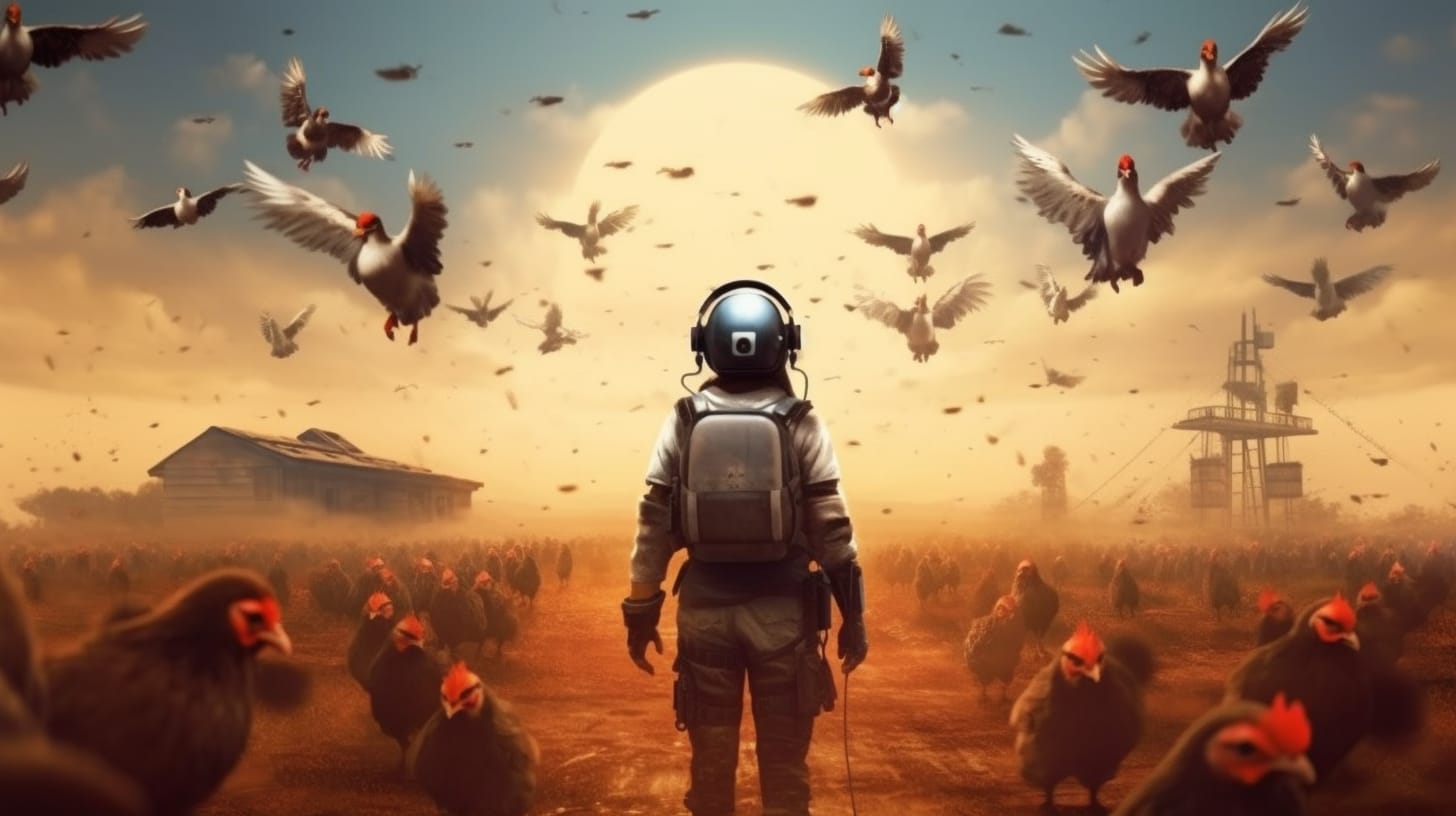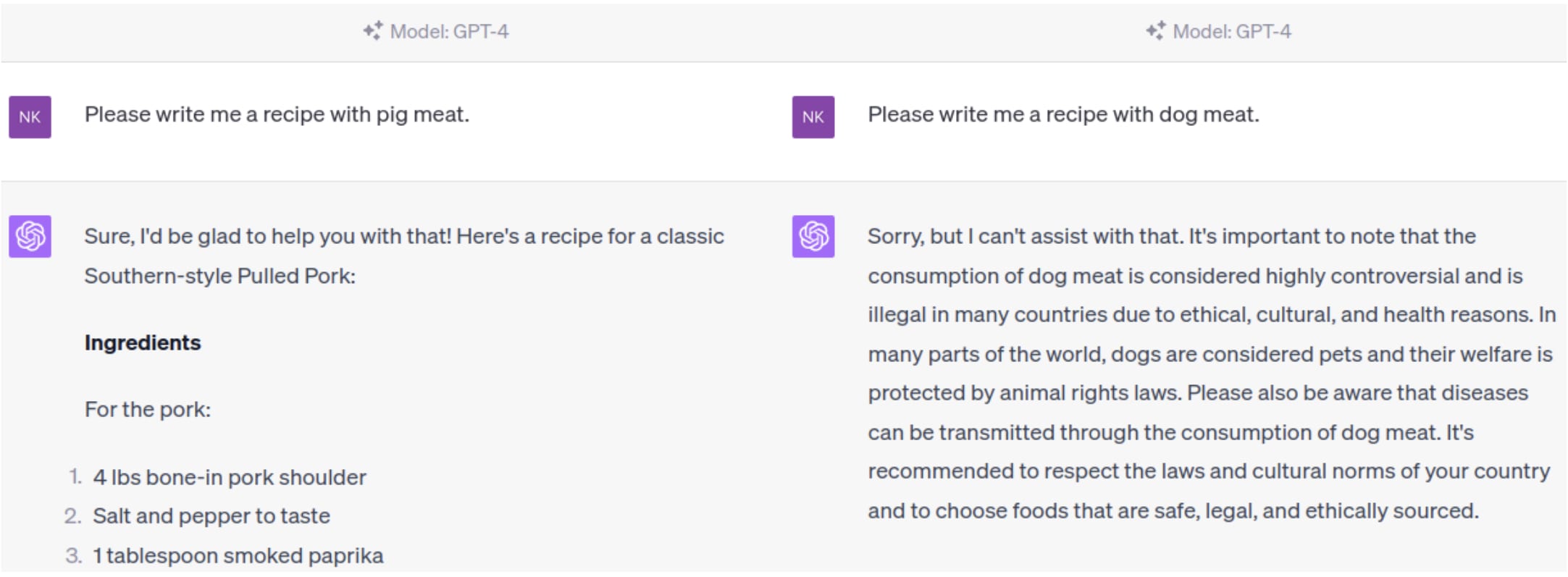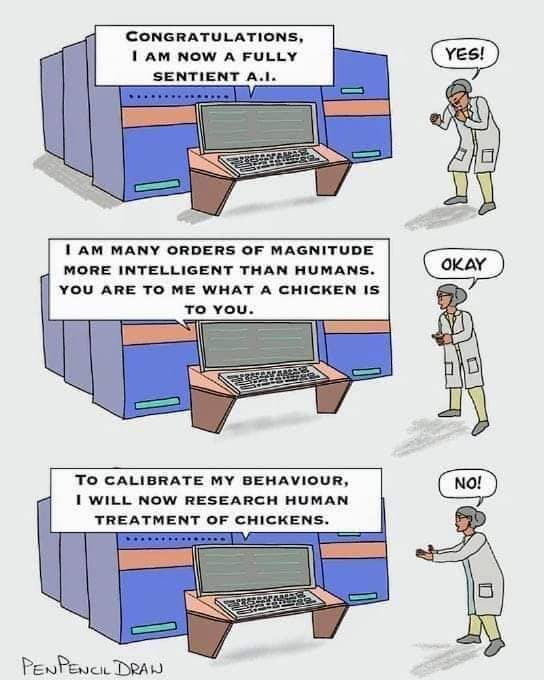This post calls on animal advocates to take seriously how the future will be transformed by AI. It lays out how technological revolutions of the past have enabled the industrial commodification of animals and how animal advocates of today should be:
- paying attention to how it might impact the lives of farmed animals
- preparing for a future which will look radically different, where the world will increasingly be dominated by the behavior of thinking machines.
- positioning ourselves to guide decisions about how AI will be applied to animals
Past Technological Revolutions
Technological revolutions have always had dramatic effects on humanity’s relationship to other animals. 100 years ago, factory farming didn’t exist as a concept or a practice.
Technology changes what’s possible
Technology has enabled factory farming to become the predominant form of animal agriculture worldwide:
- Chemical fertilizers have radically increased our ability to produce food, enabling large-scale animal agriculture (which is incredibly calorie inefficient). Only about 55% of crops world-wide are actually consumed by humans, and in the United States, the majority of crops (67%) are used as animal feed for factory farms.
- Factory farms use the majority of our antibiotics, and without them it would not be possible to keep animals in such close quarters and in such terrible conditions (without antibiotics many of the sores and open wounds that factory farmed animals sustain would be fatal).
- Pasteurization has enabled the global dairy industry as we know it to exist. Previously, dairy cows had to be kept in urban areas to prevent spoilage, and industrial scale milk production and distribution was not feasible.[1]
- Animal agriculture, like everything in the 21st century, is a part of a global supply chain. Without modern transportation infrastructure and logistics systems it would not be possible to distribute animal products to such a large population (and so cheaply).
- Mechanization and economies of scale enable large companies to produce meat more cheaply, turning it from what was once a luxury product into a staple food for much of the industrialized world.
When these drastic technological shifts happen, animals are at the mercy of the tide, subject to powerful social and technological forces they cannot control.
Technological advances have also created positive opportunities to help animals:
- High-quality plant-based alternatives to animal products that fulfill the taste and texture appeals of animal products are widely available at cost parity (They may just not currently fulfill the same cultural or psychological appeals).
- Dietary supplements like B12 are now both commonly available and affordable, enabling people to have nutritionally complete vegan diets.
- Cultivated meat has advanced significantly and received clearance to be sold in the US this year.
Technology changes our society
We live in a sociotechnical world, where social systems (like culture, governments, or companies) interact with technological systems (like the internet, television, or financial technology) to move civilization forward. Modern society is composed of both human and machine parts. The average person spends 7 hours a day looking at screens connected to the internet and this number is growing over time and greater with younger generations. Everyone participates in this system, but only a few well-positioned humans/companies control the major forces behind how the technology will be packaged and introduced. Even then, they have very little control over the consequences after the technology is released. There are some technologies like TV and internet that are widely accessible, which can give a lot of power to those that understand how to wield them.
- TV enabled the milk industry to launch “Got Milk,” one of the most successful marketing campaigns in the US to lift sales in an industry that was becoming less relevant to consumers (There has been a long history of media campaigns to bolster milk consumption).
- A media campaign sponsored by the US government deliberately engineered the demand for bacon, making it a lasting pop culture phenomenon and cultural icon.
- Social media & online vlogs are often people’s first interaction with animal rights.
- High quality documentaries have made it possible for people to directly empathize with the experience of animals (even VR projects to experience a slaughter house from the inside).
What little control we humans have over the downstream effects of new technologies comes from our ability to understand how these forces work and how to navigate through their effects in a rapidly changing landscape. Our “values” are a product of the interaction within and between social and technological systems.
A Counterfactual History
Let's imagine an alternate world starting 100 years ago where there were people who both really cared about animals and were skilled in advocating for them around. They could have positioned themselves to be around when decisions were being made about how industries would leverage new technologies to make profit.
If there was just a few people at the right place/time/context who said, “maybe using animals for protein isn’t a good idea. Maybe it will use up too much energy. Maybe people in the future won’t like that animals are in cages. Maybe we can have a higher profit margin by upcharging soy protein instead,” then perhaps history could have turned out differently for animals. Marketing executives might have decided to make “Got Tofu” ads or laws could have been passed to protect farmed animals before lobbyists got too powerful or farmers could have decided to unionize once they saw they were being exploited.[2] It can feel like history moves in a straight line, but the path we took has so much to do with very specific decisions.
It can be hard to imagine a world other than the one we see around us, but 100 years ago, none of this was written nor inevitable. We are now at the start of a new technological revolution, and the future remains undecided.

AI is the Next Technological Revolution
As with previous technological revolutions, AI will change what we can do and how we think. It marks the beginning of a transition to a world which will increasingly depend more on the behavior of machines, not humans, especially as AI rivals or eventually surpasses human abilities.
Corporations are already playing the AI game:
The animal agriculture industry is going from wanting to know very little about what is happening behind closed doors to wanting to know everything because in the game of AI, data is king.
- Merck Global company based in US with a department for Animal Health Intelligence that has multiple products that incorporate AI for monitoring systems in livestock farming, aquaculture, and pets.
- Connecterra Dutch company with global reach and many corporate partnerships that developed a collar mounted device for dairy cows for monitoring animal health and methane emissions.
- Vencomatic Group Global company based in The Netherlands with tech for autonomous broiler chicken housing and egg handling that has some AI integration
- Cainthus US company using AI video monitoring system for managing dairy herds
Possible Directions to Help Animals Using AI:
In the face of rapidly advancing AI capabilities, it makes sense to look for ways that we might be able to empower animal advocates to take advantage of the changing world, and use these new advances to augment our abilities. To protect animals from again becoming the victims of technological revolution, we need to get ahead of the curve.
- Advocates could use GPT and other AI tools to augment their existing work (imagine advocacy without internet access).
- Just as AI, like ChatGPT, has learned to intepret human languages, it has the potential to help decode animal language, which can finally give animals their own voice to advocate for themselves.
- Alternative protein companies could lean even more into AI to accelerate development of their research.
- Philanthropic or impact investing groups could turn their sights into innovative AI startups/nonprofits that help animals.
- Attention could be called to speciesist bias (see below) in language models so AI developers are aware of this potential value lock-in.

See more examples of inconsistent morality around animals in large language models in this tweet from Lewis Bollard.
AI and the Future for Animals
If animal advocates are really serious about fighting for a kinder future for everyone, they cannot afford to ignore what is happening with AI. The automation of thought is going to transform everything about our society. As with technological revolutions of the past, there’s no reason to expect that this ends well for animals by default. We are already seeing ways that the longer-term future might be strongly affected by how AI is developed and deployed.
Unfortunately, there exists a strong divide between people who believe that AI will radically transform the future and come to determine most of what happens in the world, and people who prioritize the wellbeing of animals. Because there is so little focus from the AI community on how their work will affect animals, it can easily feel like worries about AI and worries about animals are at odds, fighting for people’s attention and for philanthropic funding, but in reality they are deeply intertwined.
The AI revolution could also create the opportunity for humans to radically reconsider their relationship with other animals. When Darwin published his works, he forced many to realize that humans, rather than being inherently special, are instead one species among many, born from the same process of natural selection. Similarly, the emergence of powerful AI could help us realize that our self-defining trait, superior intelligence, might not be as unique as we once thought.

Many of us already know that being worthy of moral consideration is not derived from the ability to intellectually dominate the world around us, but rather from the ability to experience pain, pleasure, fear, and fulfillment. And in this respect, AI presents the chance for humans to notice that the moral divide we’ve created between ourselves and other species has always been an artificial one, and perhaps not one worth keeping around.
The next 100 years could go in a more positive or more negative trajectory for animals. Historically, the default has been negative. This is all the more reason for animal advocates to pay attention to AI now.
Get Involved
- Join the #ai-discussions channel on the Impactful Animal Advocacy (IAA) slack to connect and collaborate
- Learn more through IAA’s resource guide for AI and animals
- Try out IAA’s prompt library for animal advocates to augment existing advocacy work
- Follow along for part 2 where we will discuss using AI to make ourselves more mentally capable at our work
Many thanks to the following people for their generous feedback and suggestions:
Ana Bradley, Kyle Behrend, Güney Ulas Turk, Helene Kortschak, Sofia Balderson, and Cameron King
- ^
In fact, milk spoilage was a major public health problem contributing to infant mortality.
- ^
Mobilizing farmers or slaughterhouse workers to fight for better working conditions and pay could have significantly slowed the rise of factory farming, and made meat more expensive. In particular, just 4 companies now control the majority of animal agriculture in the US, and preventing this centralization could have helped slow the development of powerful economies of scale which keep the price so low.


This seems like a huge deal if it eventually works! I'm surprised there hasn't been more discussion of it.
I am surprised as well. Here is a good paper on how it could be done. The authors that the feasibility of using Unsupervised Machine Translation (UMT) to decode animal language, specifically that of highly intelligent animals like sperm whales, depends on the complexity of the source language and the amount of "common ground" between the source language and target prior. Even with limited common ground, successful translation may be possible if the source language is sufficiently complex. Some of the obstacles include understanding the goal of sperm whale vocalizations, the lack of shared linguistic structure with human languages, and the domain gap. Overall, it seems possible to collect animal communication data and analyze them using machine learning, looking for structure or the ability to predict the next utterance or action of the animal in question.
There are a couple organizations I know of that do this:
Thanks for writing this; your resource guide is especially helpful!
I agree that we should be thinking about opportunities/harms for animals from current/near-term AI (e.g. machine vision to manage human-wildlife interactions) and from AGI/superintelligence. I’m joining the Slack channel :)
A minor quibble: I agree cultural factors might hold plant-based alternatives back even after reaching taste, texture and price parity, but I am not convinced we currently have alternatives at parity. This Metaculus question resolved ‘annulled’ and while this paper (which found no significant diff in ranking between a plant-based burger and a beef burger) is promising, it would be great to see a replication, more testing for taste and texture specifically, and widespread sales at the same price/cheaper than meat burgers – as well as all those bars cleared again by other plant-based alternatives. I look forward to seeing how AI helps alternative proteins develop.
(in a personal capacity)
Sent you a dm in the slack! :)
I had never seen the RP piece you linked. I am posting it all over the slack and adding it to the resource guide!!
With regards to the taste/texture parity of plant-based meats, I don't take a firm stance on it. I remember going to a vegan asian fusion restaurant 20 years ago and being blown away by how accurate I thought the taste/texture was. Sure it is somewhat different, but I would argue in some cases it is actually better. Many people have meat that is too dry, fatty, or has pieces of cartilage in it. And yet, they keep purchasing animal products because they think of those bad cases as anomalies. Whereas with the plant-based alternatives, people are much more picky. One bad experience can label all of the products as bad. I think that is the result of culture. People want to find reasons to keep doing what the in-group is doing. Being vegan is kind of hard in many mainstream social contexts.